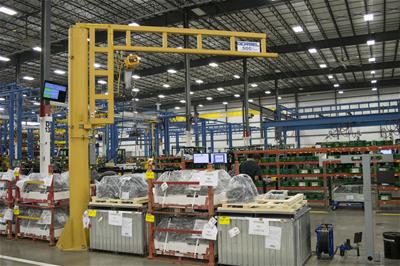As outlined in our previous blog post, jib cranes can provide a major boost to your plant or warehouse operations. However, many people are unaware of the many safety-related benefits they can bring to your workplace. From reducing injuries to promoting a smooth training experience, jib cranes can help you in your quest to establish a culture of safety within your business. Here are the top four ways jib cranes contribute to workplace safety. 
1) They help reduce injury
"In order to minimize workplace injury and illness, occupational safety professionals try to understand what the most prominent are and the reasons they occur....Handling objects, substances, or materials otherwise capable of injury comprises 32% of The Travelers Companies, Inc. total claims. That's followed by slips, trips and falls which account for 16% of their claims." - Eastern Kentucky University
Injuries related to lifting or handling objects or materials account for the largest percentage of workplace injuries. By providing a safe means of lifting and transporting loads, jib cranes can dramatically reduce the number of strains, sprains, and other injuries sustained by employees attempting to lift loads over 50 pounds.
2) They help reduce overcrowding
Many of today's warehouses and plants are busting at the seams with equipment, product, and workers. And facilities that are overcrowded leave employees at greater risk for injury. By installing ergonomic jib cranes instead of traditional cranes, you can maximize warehouse space, clean up overcrowded aisles, and help prevent injury.
3) Fewer parts equates to fewer breakdowns
While jib cranes are designed with safety in mind, no piece of equipment is immune to breakdowns. But because jib cranes have a simpler design that features a smaller number of components, they are less likely to breakdown and potentially cause an injury to an operator or other employee working nearby.
4) A simpler design promotes successful safety training
Safety training should be your top priority when introducing a jib crane or any new piece of equipment to your production staff. With their simple design, jib cranes are easier to operate. Employees can master operation faster and can quickly learn how to perform regular inspections because there are fewer moving parts.
What factors should you consider before buying a jib crane?
Given the collection of benefits outlined above, you may be wondering which type of jib crane would be the best fit for your application. In order to answer this question, it is a good idea to carefully survey the space you have in mind in conjunction with the goals you wish to achieve with your crane. Here are some specific factors to consider when choosing which type of jib crane will best meet your needs:
- Structural support needs: Before you settle upon a model, make sure that your wall or floor is capable of supporting the crane.
- Power requirements: Consider your current and future power requirements, as not all types offer a motorized option.
- Your budget: Generally speaking, wall mount versions are less expensive because you do not have to install a floor foundation.
- Installation time: Jib cranes take time to install. Floor mount models typically take longer because a foundation often needs to be poured.
- Delivery time: If you need a jib crane quickly, be sure to choose a high quality crane that can be delivered in 5 days or less.
What is the best path to securing ergonomic jib cranes?
As described above, jib cranes play a key role in boosting productivity and workplace safety. However, not all jib cranes are created equal. The single best way to ensure that you choose a dependable jib crane is to source your cranes from an expert in the ergonomic lifting industry. With over four decades of experience supplying jib cranes to manufacturers and industrial companies, Gorbel has become the nation's most trusted supplier of ergonomic jib cranes. The crane experts with Gorbel look forward to assisting you with all of your lifting and fall protection equipment!